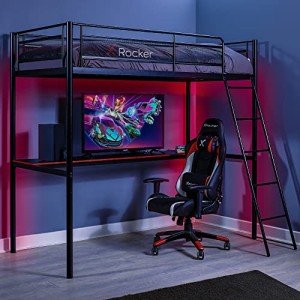The Most Hilarious Complaints We've Heard About Bunk Bed
A Comprehensive Guide to Children's Bunk Beds: Styles, Benefits, and Safety Considerations
Bunk beds have become a popular choice for households aiming to make the most of space and supply a fun sleeping environment for kids. With their distinct style, they offer an innovative and useful service for shared bedrooms, playrooms, and even guest lodging. This short article explores the various designs of children's bunk beds, their advantages, safety factors to consider, and answers some often asked concerns.
The Allure of Bunk Beds
Children's bunk beds are more than simply space-saving structures; they are also a gateway to adventurous dreams and creative play. Below is hassangamble.top detailed examination of their numerous advantages.
Advantages of Bunk Beds
- Space-Saving: Bunk beds effectively use vertical space, making them a perfect choice for smaller sized spaces.
- Spirited Design: Many bunk bed styles include slides, tents, and themed components, sparking imagination and enjoyment.
- Partner Sharing: Bunk beds are ideal for brother or sisters sharing a space or accommodating slumber parties.
- Flexible Use: Some models can be separated into two private beds, providing flexibility as children grow.
- Storage Options: Many bunk beds come with integrated drawer storage or racks, further enhancing their functionality.
Designs of Children's Bunk Beds
The range of bunk beds readily available today accommodates different choices and requirements. Below is an overview of some popular designs.
Style
Description
Best For
Standard Bunk Bed
A conventional style including one bed stacked above another.
Siblings sharing a room.
Loft Bed
Similar to a bunk bed without the bottom bunk, permits a workspace or play location below.
Limited space for play/desk.
L-Shaped Bunk Bed
Two beds arranged in an L-shape, typically with extra sections for storage or play.
Special room layouts.
Twin Over Full
A twin bed over a complete bed, accommodating different sleep requirements.
Growing children and teens.
High Sleeper
Stands even greater than a loft bed, normally featuring a desk or play location listed below.
Older kids needing more play/desk space.
Tent Bunk Bed
Bunk beds with a canopy or tent-like structure, creating a relaxing, enjoyable space.
Active and creative kids.
Secret Features to Consider
When picking the best bunk bed for kids, the following functions deserve thinking about:
- Material: Bunk beds can be made from wood, metal, or a mix. Each has its special visual and toughness.
- Weight Capacity: Always verify the weight limit of the bunk bed to guarantee it can accommodate your kids safely.
- Safety Rails: Ensure the leading bunk has durable rails to prevent falls.
- Ladder Security: A properly designed ladder needs to use easy and safe access to the upper bunk.
- Ending up: Ensure any surfaces are non-toxic and safe for kids.
Safety Considerations
Safety is paramount when it pertains to kids's bunk beds. The following guidelines ought to be followed:
- Age Appropriateness: Generally, children under six years of ages should not sleep in the upper bunk due to security dangers.
- Sturdy Construction: Ensure the frame and products are solid and can support the weight without drooping.
- Regular Maintenance: Periodically look for loose screws, bolts, or other components that might require tightening up.
- Clear Play Area: Keep the area around the bunk bed complimentary of toys and barriers to reduce tripping dangers.
Setting Rules for Safe Use
Developing standards for bunk bed usage will help make sure security:
- Limit Jumping and Climbing: Children need to be encouraged against jumping from the top bunk and getting on the sides.
- Supervising Sleepovers: Monitor young guests while they are using the bunk bed for the very first time.
- Inform on Ladder Use: Teach how to utilize the ladder securely, stressing the significance of dealing with the ladder when going up or down.
Often Asked Questions
1. What age is proper for a kid to oversleep the leading bunk?
Many producers advise that kids must be at least six years old to sleep in the upper bunk. This guideline is developed to alleviate the risk of falls.
2. Can bunk beds be personalized?
Yes, lots of manufacturers use adjustable choices, including colors, materials, and additional functions like drawers or desks.
3. Are bunk beds safe for weight?
Bunk beds have weight limits, generally varying from 200 to 400 pounds, depending upon the model and material. Always check the producer's specs.
4. How do I preserve and clean up a bunk bed?
Frequently inspect for loose parts, keep the bed clean by cleaning down surfaces, and make sure the bedding is fresh to promote a safe and sanitary sleep environment.
5. Can bunk beds be separated into individual beds?
Lots of bunk beds feature an option to separate them into two individual beds, supplying long-term flexibility.
Children's bunk beds are more than simple furniture; they are a practical, versatile, and creative element of a child's room. With various styles readily available and many security factors to consider to keep in mind, moms and dads can pick the perfect bed that fits their space, satisfies their kids's requirements, and instills a sense of experience. By understanding the advantages, designs, and precaution related to bunk beds, families can produce a delightful and safe sleeping environment for their kids. Whether for brother or sisters sharing a room or space-saving services, bunk beds remain a precious option for many homes.
